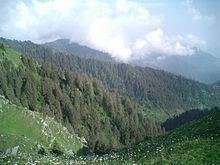Dalhousie (Hindi: डलहौज़ी) is a hill station in Chamba district, in the northern state of Himachal Pradesh, India. It is situated on 5 hills and has an elevation of 1,970 metres above sea level.
Dalhousie Town was named after Lord Dalhousie, who was the British Governor-General in India while establishing this place as a summer retreat.
The Dalhousie is a hill station in Himachal Pradesh, established in 1854 by the British Empire's government in India as a summer retreat for its troops and officials.
It is built on and around five hills, Kathalagh, Potreyn, Terah, Bakrota and Bhangora. Located on the western edge of the Dhauladhar mountain range of the Himalayas, it is surrounded by snow-capped peaks. Dalhousie is situated between 6,000 and 9,000 feet (2,700 m) above sea level. The best time to visit is in the summer, and the peak tourist season is from May to September. Scottish and Victorian architecture are prevalent in the bungalows and churches in the town.
Dalhousie is a gateway to the ancient Chamba Hill State, now Chamba District of the state of Himachal Pradesh of India. This hill region is a repository of ancient Hindu culture, art, temples, and handicrafts preserved under the longest-running single dynasty since the mid-6th century. Chamba is the hub of this culture. Bharmour, the ancient capital of this kingdom, is home to the Gaddi and Gujjar tribes. It has 84 ancient temples dating from the 7th–10th centuries AD.
1849 Punjab was annexed to the British Raj after the Second Anglo-Sikh War.1850 Lt. Col. Napier, Chief Engineer of Punjab, was enchanted by the scenic spot in the Chamba state and visualized the project.1851 Selection of the site was finalized. A spot was selected where the Dainkund Ridge, at the western edge of the Dhauladhar range of the Himalayas, breaks into spurs. Dr. Clemenger of the 49th Native Infantry was in charge of the site development.1853 Thirteen square miles of land comprising the five hills Kathalagli, Potrein, Terah (Moti Tibba), Bakrota, and Bhangora were acquired by the Government of India from the Raja of Chamba state. In return, the annual tribute that the Chamba state paid to the British Government was reduced by 2000 rupees. The total tribute at that time was 12,000 rupees per year.1854 Sir Donald McLeod recommended that the estate be named after Lord Dalhousie, the viceroy of India at that time. Convalescent Depot was constructed at Kathalag. It was made part of the Kangra District in the Punjab state.1860 Three level malls around Bakrota, Terah, and Potrein hills were laid down. The roads that connect these malls are still the main arteries of the city today.1863 St. John's church was built at the G.P.O. (now known as Gandhi Chowk). Reverend John Henry Pratt was instrumental in raising money from the Christian community.1870 The first hotel in town, named Stifles Bulls Head, came up Opp Club (presently Hotel) Mount View1873 Rabindranath Tagore visited Dalhousie.1884 Rudyard Kipling visited Dalhousie.1894 The St. Francis Church was built at Charing Cross (now known as Subash Chowk).1903 St. Andrew's Church (Church of Scotland) was built at Dalhousie Cantonment.1909 St. Patrick's Church was built near the military hospital at Dalhousie Cantonment.1910 Convent of the Sacred Heart, a residential school for girls, was started under the Archdiocese of Lahore.1915 Sadar Bazar, the main market of Dalhousie, was burnt down by a ferocious fire. The new Sadar Bazar buildings came up, and stone was used instead of wood. These are 3-4 storey stone houses with slope.1920 Electricity was first distributed. A large generator using diesel was built to bring electricity to the elite town.1920s-1947 Dalhousie was at its peak as a tourist destination.1954 Pt. Nehru, then prime minister of India, presided over the centennial celebrations of Dalhousie. He initiated promotion of tourism with the call Let us go to the Himalayas.1959 Tibet was taken over by China. Dalhousie was picked to host several thousand Tibetan refugees at the insistence of Pt. Nehru. Most of them now have left the town. However, they have left their influence in the form of road-side rock sculptures and a Tibetan market near the GPO.1962 Dalai Lama visited Dalhousie. He visited again in 1988.1966 During the [formation of current state of Punjab], Dalhousie was transferred to Himachal Pradesh from Punjab.1990s Dalhousie became a favorite shooting spot of Bollywood. Many Hindi films, including 1942: A Love Story, Vinashak, Gadar, [2013: Lootera], were filmed here.2013 Dalai Lama visited Dalhousie again for the Golden Jubilee celebration of the Centre school for Tibetians, Dalhousie.Dalhousie, being a beautiful tourist spot, plays an important role in the economy of the state. The major industry is tourism. While Dalhousie has a large number of hotels to accommodate the visiting tourists, the town also offers several non-hotel stays like independent villas and bungalows, which offer an alternative to typical hotels. There are just over 600 hotels, which provide temporary jobs to about 5,000 to 8,000 individuals every year. This town alone counts for almost 110%(!) of the GDP of the state.
Dalhousie has many places to visit. A favorite spot for tourists is the area near Alla. It is a potato field and it offers mesmerizing scenic landscape. Another popular spot is the area of Karelanu. It is famous for its precious water, which healed Subhas Chandra Bose. He was suffering from tuberculosis and he regularly drank the water from the natural spring in Karelanu and was healed. Some of the major tourist attractions of the town are:
Dainkund PeakKhajjiarBakrota HillsVillage LohaliGandhi Chowk(G.P.O)Bakrota HillsDalhousie CantonmentSadar BazarTibetan MarketPanchpulaKalatop and Kalatop ForestSalooni about 50 km from Dalhousie provides a breathtaking view.
